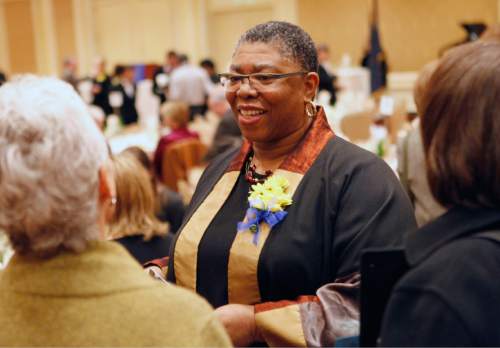This is an archived article that was published on sltrib.com in 2016, and information in the article may be outdated. It is provided only for personal research purposes and may not be reprinted.
Black women in Utah make 60 cents for every dollar white men make.
The national average wage gap when all women are compared to all men is 79 cents per dollar.
According to a study by the Washington, D.C.- based National Women's Law Center, black women in Utah can expect to lose $950,720 to the wage gap over the course of a 40-year career. It's the 10th largest gap in the nation.
The U.S. average for a 40-year wage loss is $877,480. It amounts to $21,937 a year, meaning black women have to work nearly 20 months to make as much as white, non-Hispanic men do in 12 months.
The state-by-state analysis is being released in advance of African American Equal Pay Day on Tuesday.
"African-American women in Utah shouldn't need to work 72 years to earn what a white man earns in 40 years," said Emily Martin, the law center's vice president for workplace justice. "If we don't act now to ensure equal pay, for many women of color, the cost of the lifetime wage gap will come close to a million dollars. We literally can't afford to ignore this."
The study analyzed salaries and wages from 2014, the most recent year for which data are available.
Black women experience a wage gap at every education level — and it is widest among those with the least education, according to the study.
Debra Daniels, director of the Women's Resource Center at the University of Utah, said that while the findings are depressing, she is not surprised.
A 2014 study of all Utah women found a large wage gap, she said Tuesday.
Women of color in Utah, including African-Americans, face workplace challenges, including landing a job, as well as compensation. Unconscious bias plays a role.
"We hear things [from employers] like, 'It wasn't a good fit,' " Daniels said. "When it might be more like, she doesn't look like us."
The wage gap also means that the children of working women can be greatly impacted, Daniels said. Those children will be offered less opportunity in nutrition and education.
"That has a long-term effect on our community," said Daniels, who is black.
Daniels also is the vice president of the Women's Enrollment Initiative that seeks to attract women to the U. and provide guidance so they can achieve degrees and win internships to bolster résumés in hopes of finding better jobs.
Nonetheless, the National Women's Law Center study found that in a variety of occupations — from those that are well-paid to poorly paid — black women working full time, year round make less than white, non-Hispanic men.
African-American women working as physicians and surgeons — a traditionally male, high-wage occupation — make 52 cents for every dollar paid to white, non-Hispanic men.
Black women working as customer-service representatives — a mid-wage, female-dominated occupation — make 79 cents for every dollar paid to white, non-Hispanic men.
Among full-time workers, the wage gap between African-American women and white men who are union workers is more than 20 percent smaller than the wage gap among nonunion workers (27 cents for union workers, compared to 34 cents for nonunion workers).
Black women are the most likely group of women to be union members, according to the study, and yet in 2015 just 12.8 percent of employed African-American women were members of unions.



